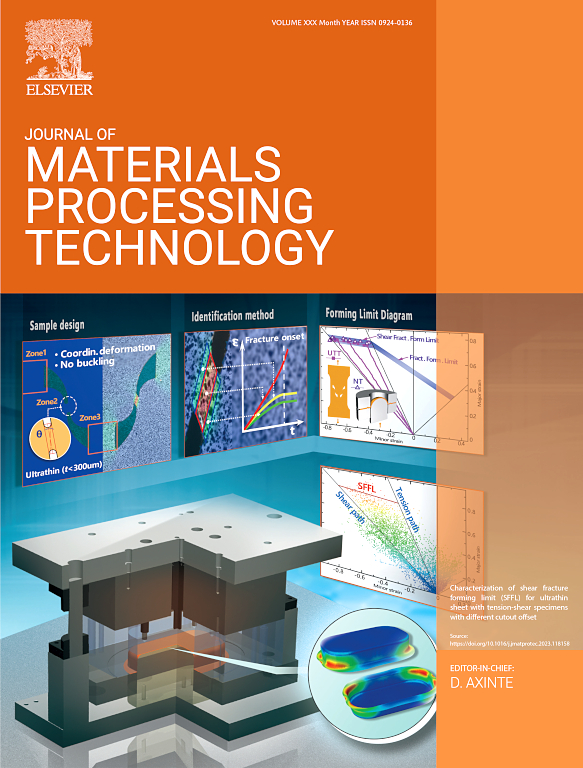Study on the crack healing behavior of aluminum alloy under the action of pulse electric current
IF 6.7
2区 材料科学
Q1 ENGINEERING, INDUSTRIAL
Journal of Materials Processing Technology
Pub Date : 2025-03-16
DOI:10.1016/j.jmatprotec.2025.118803
引用次数: 0
Abstract
Aerospace structural parts fabricated from aluminum alloy are susceptible to crack damage during service, which diminishes the safety and life of the equipment. Compared with conventional repair methods, pulse electric current treatment can precisely locate cracks distributed throughout the material and enable efficient in-situ repair. Therefore, this study employs the pulse electric current treatment method to repair cracks and investigates the crack healing behavior using a combination of experiments and simulations. The effect of pulse electric current treatment on the crack-containing sample is revealed through a finite element method simulation. The electric current density, temperature, stresses, and displacements are all concentrated in the crack area and influence each other step by step, thereby gradually driving crack healing. The experimental results indicate that after pulse electric current treatment, the mechanical properties of the crack-containing sample are significantly recovered, with the tensile strength and elongation increasing by 23.2 % and ∼ 2 times, respectively. Metallurgical bonding and densification are achieved between the crack surfaces, and the healed interface possesses higher bonding strength. Combined with molecular dynamics simulations, the crack healing process under the action of pulse electric current is elucidated. While recrystallization occurs in the crack area, a large number of dislocations are continuously emitted and move from the crack tip, and the grain boundaries continuously progressively migrate toward the crack. The plastic deformation behavior at high temperature prompts the diffusion and migration between the atoms on both sides of the crack and the formation of fibrous bridging structures. This work provides new insights into the crack healing mechanism under the action of pulse electric current and contributes to the optimization of crack repair technology to enhance the reusability of aerospace equipment.
脉冲电流作用下铝合金裂纹愈合行为的研究
铝合金制造的航天结构件在使用过程中容易发生裂纹损伤,降低了设备的安全性和使用寿命。与传统修复方法相比,脉冲电流处理可以精确定位分布在材料各处的裂纹,实现高效的原位修复。因此,本研究采用脉冲电流处理方法修复裂纹,并采用实验与模拟相结合的方法研究裂纹的愈合行为。通过有限元模拟揭示了脉冲电流处理对含裂纹试样的影响。电流密度、温度、应力、位移等都集中在裂纹区域,并逐步相互影响,从而逐步推动裂纹愈合。实验结果表明,脉冲电流处理后,含裂纹试样的力学性能得到明显恢复,抗拉强度和伸长率分别提高了23.2% %和~ 2倍。裂纹表面之间实现了冶金结合和致密化,愈合后的界面具有较高的结合强度。结合分子动力学模拟,阐述了脉冲电流作用下的裂纹愈合过程。在裂纹区域发生再结晶的同时,大量位错不断地从裂纹尖端发出并移动,晶界不断地向裂纹逐渐迁移。高温下的塑性变形行为促使裂纹两侧原子间的扩散和迁移,形成纤维桥接结构。本研究为研究脉冲电流作用下裂纹修复机理提供了新的思路,有助于优化裂纹修复技术,提高航天设备的重复使用性能。
本文章由计算机程序翻译,如有差异,请以英文原文为准。
求助全文
约1分钟内获得全文
求助全文
来源期刊

Journal of Materials Processing Technology
工程技术-材料科学:综合
CiteScore
12.60
自引率
4.80%
发文量
403
审稿时长
29 days
期刊介绍:
The Journal of Materials Processing Technology covers the processing techniques used in manufacturing components from metals and other materials. The journal aims to publish full research papers of original, significant and rigorous work and so to contribute to increased production efficiency and improved component performance.
Areas of interest to the journal include:
• Casting, forming and machining
• Additive processing and joining technologies
• The evolution of material properties under the specific conditions met in manufacturing processes
• Surface engineering when it relates specifically to a manufacturing process
• Design and behavior of equipment and tools.
 求助内容:
求助内容: 应助结果提醒方式:
应助结果提醒方式:


